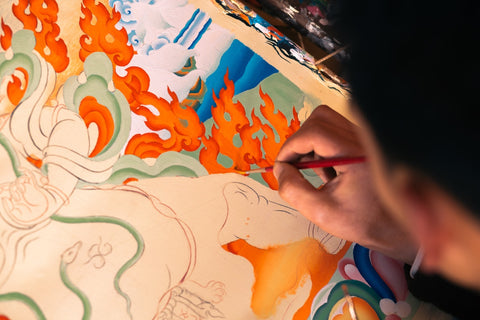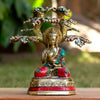Thangka Painting: A Buddhist Art

What is Thangka
Thangka is a Silk painting and weaving, normally showing a Buddhist god, acclaimed scene, or a mandala. The Thangka is totally different than ordinary oil painting. It is a piece of picture which is painted or weaved and laid a cover of silk. Good amount of dedication and hard work is must for Thangka Paintings. Thangkas are the true Art of Religion.

Motivation behind Thangka
Thangka is a Nepali type of craftsmanship sent out to Tibet by princess Bhrikuti ( Harit Tara - little girl of Ansuvarma) of Nepal (seventh Century) wedded to Sron Tsan Gampo, the then leader of Tibet. "Thangka" is accepted to have come from the Tibetan word "thang yig" which means a set up account. Initially, thangka compositions got famous among voyagers and priests as an instructing device to outline life history of Gautam Buddha, lamas, other god/goddess. Quite possibly the most well known subjects seen in thangkas is "The wheel of life" which is the visual portrayal of Abhidharma lessons or the craft of illumination.
Related: Buy Mala Beads Online
Kinds of Thangka
In view of method and materials of painting Thangkas can be gathered by types. For the most part, they are isolated into two general classes: those that are painted and those made of silk by weaving Average Thangkas are minuscule, between around 18 and 30 inches tall or wide, there are likewise monster celebration Thangkas and intended to be unrolled against a divider in a cloister for specific strict events. These are probably going to be more extensive than they are tall, and might be at least sixty feet across and conceivably at least twenty high.Thangka Painting
Thangkas are painted on cotton or silk. The most ordinarily utilized are approximately woven cotton created in widths from 40 to 58 centimeters (16 - 23 inches). While a few contrasts do exist, Thangkas more extensive than 45 centimeters (17 or 18 inches) typically have layers in help. The paint comprises of water solvent colors. Both mineral and natural colors are utilized, solidified with spice and paste arrangement. In Western phrasing, this is a sickness procedure. The sythesis of a thangka, likewise with the mainstream Buddhist craftsmanship, is exceptionally coherent. Arms, legs, eyes, nostrils, ears, and different ceremonial carries out are completely orchestrated out on a precise snare of points and crossing lines. A talented Thangka Artist will typically choose from a scope of predesigned things to remember for the magnum opus, stretching out from charity bowls and creatures, to the shape, size, and point of a figure's eyes, nose, and lips. The method appears to be very much focused, yet regularly requires profound comprehension of the creative mind required to encapsulate it.

Making of Thangka
There are various types of thangka utilizing different materials. In any case, most are painted on fabric or paper. The white material is first mounted on a casing and water-based colloid chalk is applied to the surface. It is cleaned with powder when dried. The material is in this way prepared for painting. Silk woven thangka accept the twist of brocade as the base and applies the strategy for weaving with hued silk strings as the weft.

Technique
• Line drawing is made with complete precision, extent and detail, of the divinity or wanted picture.• At that point parts of the drawing are moved by following to the silks that will be utilized in the last piece.
• Meaning of line subtleties is made by moving silk string over string and afterward via cautiously hand-sewing this to the silk pieces.
• The pieces are then removed and edges turned under and pressed. Piece by piece the picture is made with all its detail.
• Highlights like eyes, gems and blossoms are marvelously sewed utilizing uncommon weaving procedures.
• Next the individual pieces are combined, first utilizing paste and afterward sewed along each edge so the pieces structure the finished picture.
• In conclusion there are some completing lines and options of pearls like Tibetan turquoise and coral are added.
• The picture is then outlined in silk brocade.
Thangka frequently flood with creative mind and reference. Since the Thangka Art is unmistakably strict, all images and references should be as per severe rules spread out in Buddhist sacred writing. The Artist should be appropriately prepared and have adequate strict arrangement, information, and foundation to make exact and right Thangka.





